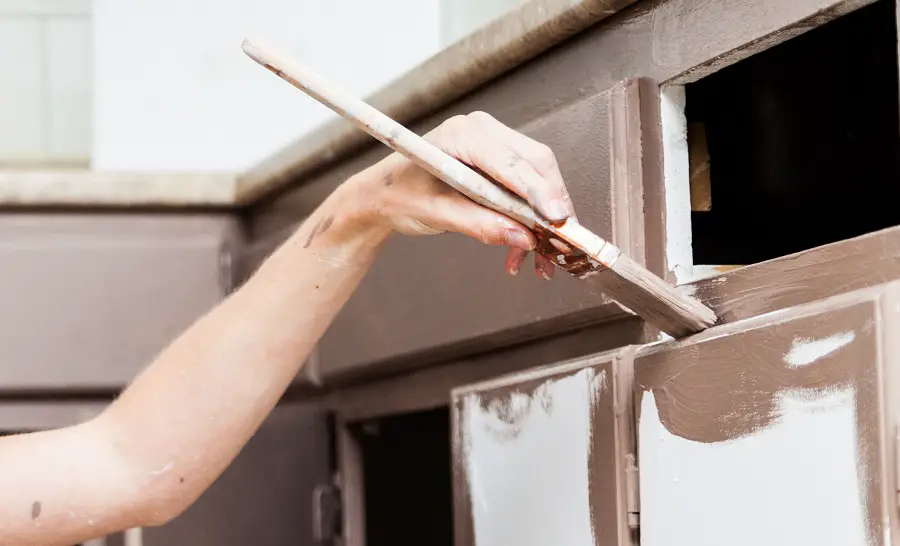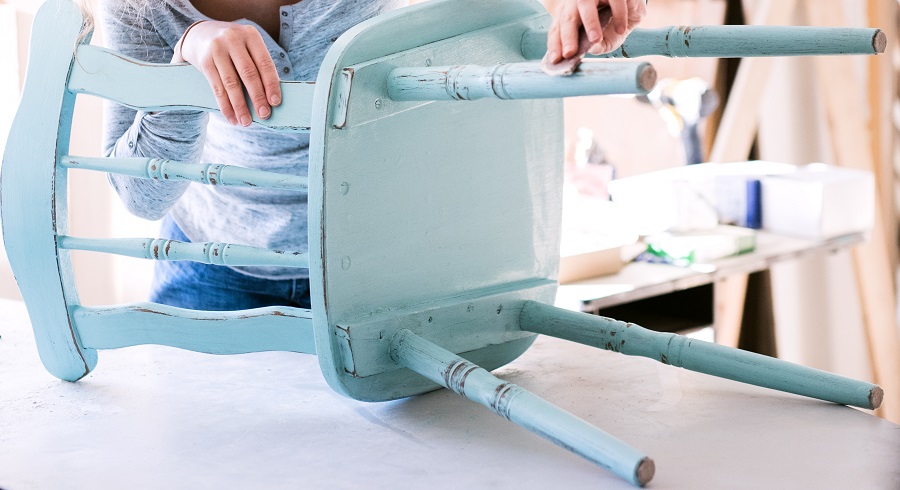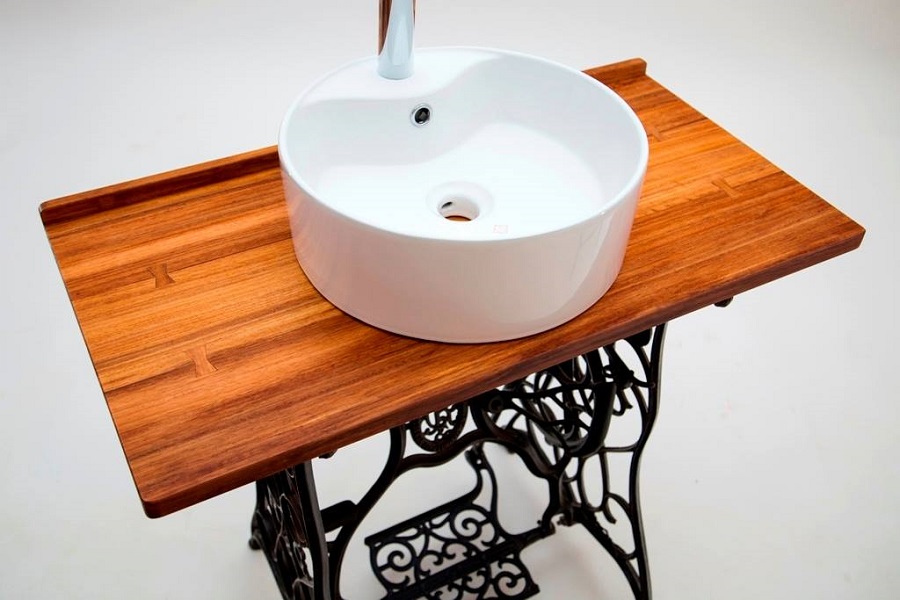The passion for DIY and transforming old pieces of furniture is catching on with more and more of our followers. Modifications are made to better suit modern interiors or to change their original purpose. Ladies are more inclined to reinvent furniture and from one of them we received the question that is the subject of the article. The lady had researched beforehand by reading magazine articles with recommendations that could be used in this case, she even sent me a sequence of the operations she intended to do - very correctly drawn up - and asked me how to do it and what materials to use so that the old piece of furniture would withstand the conditions in the bathroom. I guess she's not the only one interested in the subject so I'll detail the answer below.
What problems does a piece of furniture face in the bathroom
The main problem in the bathroom is water, both in liquid form and as cold or hot vapour. We know that the main enemy of wood is water, so wooden furniture needs to be protected so that water does not seep in and create conditions for mould and fungi to grow and eventually rot. So that water does not get into the wood, furniture must be protected on all sides with water-resistant finishing materials. Even parts that are not visible must be protectedbecause steam gets everywhere.
The furniture used in the bathroom can be solid wood, wood, veneered panels, melamine chipboard or Painted MDF. Of all these types of material, painted MDF performs best in bathroom conditions. It is a dimensionally stable material that is usually protected with chemically curing finishing materials that have very good strengths. The finish is continuous, covering the edges seamlessly between face and edge, which keeps moisture at bay. Be careful, however, with the work done for installation. If cut-outs are made, the newly emerged edges should be covered with paint because MDF tends to absorb water through the machined (cut, drilled or milled) areas.
Water and steam are also a hazard to the finish. There are varnishes and paints that do not resist moisture and bleach and flake (nitrocellulose products). There are materials which, although they resist humidity well (wax, oil), do not have very good mechanical resistance. This becomes a problem when abrasive or alcohol-based cleaning materials are used. So if you decide to use waxes or oils in your bathroom, the cleaning materials should be as gentle as possible.
Finishing materials suitable for bathroom furniture
We have seen above that oil, even wax, can be used in the bath, provided that suitable cleaning materials are used and the finish is refreshed every 6 months. The most resistant, however, are varnishes and chemically cured paints. These can be two-component or one-component, the chemical reaction being triggered by moisture in the atmosphere. It is important that after drying, the varnish or paint becomes highly resistant to water and steam, staining with different materials, scratching, abrasion and mechanical shocks.
The MDF bathroom furniture that we find in many shops is finished with polyurethane varnisheswith very good resistances or with water-based varnishes. The latter, after drying and curing, can no longer be removed by wiping with water.
The general idea is that no matter what type of material is used to protect bathroom furniture (varnishes, paints, waxes, oils, foils) they must be resistant to water and steam, they must be applied continuously or there must be a very good bond between the materials (case of melamine chipboard with edge applied edge) so that water does not seep through, they must be resistant to abrasion and mechanical action so that water does not reach the wood, veneer or derived panels.

The sequence of operations to prepare the old furniture that will be in the bathroom
Let's get back to pieces of furniture that change their purpose. As an old piece, it needs to be cleaned of dirt before a new layer is applied on top. How to clean for repainting is described at length here. Being already coated with varnish it cannot be oiled and wax does not give very good resistance at this point. It may be helpful though, I'll get back to it in a moment. So that leaves the varnish option. As we don't know what kind of varnish has been used before, it is best to use a water-based varnish as a protective coating. It is compatible with most types of varnish, but it should be noted, however, that water-based varnish is not compatible with oil-based paints. Alkyd varnish can be applied over them.
After washing and buffing, sand the old finish coat with 280 or 320 grit sandpaper or fine abrasive sponge. Apply the first coat of water-based varnish, allow to dry according to the manufacturer's recommendations, sand again lightly with the same grit and apply the second coat. Sanding between the two layers varnish helps to achieve a smooth surface and increase adhesion between coats. Application is on all sides of the furniture piece, both outside and inside.
Since the chest of drawers will be used in the bathroom, we recommended applying a thin coat of wood/furniture wax over the last coat of varnish after it has dried completely (minimum 24 hours). Apply with a soft cotton cloth, leave for 2-3 hours, then buff with a clean cotton cloth. As I always say: the best cloths in these cases are good quality old cotton shirts. The wax will be a very good protection for the freshly applied water-based varnish. In the first month, until the chemical reaction deep in the coating is complete, the waterbased varnish continues to absorb moisture from the air and can become slightly milky. It recovers when the humidity drops and the process is accelerated by the temperature. After a month to a month and a half, the phenomenon disappears by itself. Wax will protect the lake and decrease the chances of the phenomenon occurring. Over time, following daily cleaning operations, the wax will disappear, but there is no need to apply another layer.

Where more attention should be paid
As I said, the areas where the cut-outs are made for sink installation or other appliances are the most exposed areas. To avoid problems they must be well insulated, regardless of the material the furniture is made of.
If the furniture you want to transform has veneer peeling, you should reupholster the veneer before applying varnish. Find tips here and here how you can do this. Even if the dislodges are very small, the water will get there and do very serious damage.
Do not use furniture whose shape allows water to stagnate, puddling on the surface. For furniture to stay in good condition for as long as possible, water must drain away and there must be no places for it to collect and persist. This will gradually lead to mould growth and eventually to wood rot or swelling of chipboard or MDF.
I hope you find the recommendations useful if you are planning to change the use of an old piece of furniture. If you have any queries or questions, you can leave them in the space below. I will certainly answer them.


























I put pine planking on a 300 m2 terrace by the sea sanded ok with what can I give transparent to keep the natural colour, water/solvent based ?? Sand traffic - food falls what do you recommend ? Thanks !
Hello!
Finishing wood in salt air and sandy conditions is more difficult and needs to be redone almost year after year.
The most durable are boat/yacht products made to withstand outdoor use.
I would use solvent-based products. The water based ones are more elastic, softer and can be more affected by grit.
Oil can also be a solution - special oils for exterior floors - but in this case you will definitely have to refinish the floor every season, and if it is used all year round, once every 6 months. And non-coating oils only protect against moisture, not shocks and mechanical action (scratches, dents, etc).
Do not use totally transparent products because they have no protection against the sun's rays.
All the best!
Hello,
I'm about to install my cherry wood flooring and I would like your advice on the best varnishes for this type of wood. Thank you very much!
Hello!
Floor varnishes are not differentiated by wood type. Wood is chosen to withstand shock and traffic. That means you don't choose poplar wood for flooring.
Use a hardening floor varnish (type A+B) and apply 3 coats.
Good luck!